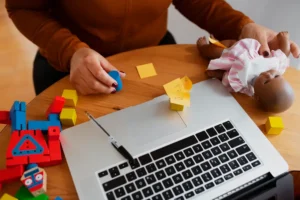How to Help a Nonverbal Child Communicate Better
Helping a nonverbal child communicate may sometimes feel overwhelming, but even the tiniest steps forward are advantageous. Learning how to express themselves helps children grow and feel more secure emotionally. As someone who cares for them, you can really help.
Every person has their own way of talking. With some patience and the right approach, you can help your child find ways to express what’s on their mind. That sense of being understood can build their confidence and help them feel more sure of themselves.
Key Takeaways
• Determining which communication methods are best for your child’s needs
• Making sure your child feels safe and supported when they try to express themselves
• Using alternative methods to facilitate communication.
• Building confidence and self-esteem through successful interactions.
Understanding Nonverbal Children
Learning about nonverbal children starts with noticing how they communicate without words. These kids might not speak or may only use a few words. They need special ways to share their thoughts and feelings with the world — and even though they don’t rely on words, they still have so much to say.
Defining Nonverbal Communication
Nonverbal communication means expressing yourself without words. For kids, that might look like making sounds, using facial expressions, or body language to show what they need. When supported effectively, these methods help children feel connected and understood.
Common Misconceptions

Many people assume that nonverbal children aren’t intelligent or don’t understand. In reality, many of these kids are highly intelligent — they simply struggle with speech. Their silence doesn’t mean they have nothing to say—it just means we need to listen in new ways and learn how to hear them.
The Importance of Early Intervention
Starting early is key for helping nonverbal children develop communication skills. The sooner the support begins, the more it can help a child find their own way to communicate.
Some helpful early strategies include:
• Recognizing the child’s attempts to communicate
• Using visual supports to aid understanding
• Creating a communication-rich environment
Using these techniques can support your child in expressing themselves with more ease and confidence.
What Causes a Child to Be Nonverbal
A child might not speak for many reasons, and understanding why is essential for choosing the right approach.
Autism Spectrum Disorder (ASD)
Some children with autism don’t find talking easy, and connecting with others or dealing with certain routines can be tough for them too.
Developmental Language Disorder (DLD)
Kids with DLD struggle to process and use language, making it hard for them to express themselves verbally.
Other Medical Conditions
Issues such as apraxia of speech or selective mutism can also affect a child’s ability to speak and often require specialized support.
Environmental Factors
A lack of exposure to rich language environments can impact a child’s speech development.
Creating a supportive, language-filled environment is essential.
Some common reasons include:
• Neurodevelopmental disorders
• Language processing difficulties
• Medical conditions affecting speech
• Environmental factors
These categories can overlap, and understanding them can guide you toward the right support.

Case Study: Meet Jamie
Jamie, a nonverbal child with autism, reminds us how important early support can be. When Jamie was diagnosed at age three, his parents quickly began helping him communicate after noticing the delays. The first step was understanding his needs and recognizing his small attempts to connect—through gestures, sounds, or pointing.
Ways to Help a Nonverbal Child Communicate at Home
His parents and siblings played a crucial role. They learned how to engage with him using visual supports and routines. By working together, Jamie’s family created a warm and safe space where he finally felt seen and understood.
Assessing Communication
Every nonverbal child communicates in unique ways. It’s important to observe how they express needs, whether through movement, eye contact, or behavior. Working with a speech-language pathologist (SLP) helps identify strengths and create a personalized plan tailored to your child.
Techniques That Work
Creating a communication-rich setting is essential. This means using visual aids, following the child’s lead, and sticking to consistent routines. Jamie, for instance, thrived on visual schedules that made his days feel predictable and safe.
Alternative Communication Methods
There’s no one-size-fits-all solution, but these tools made a real difference for Jamie:
• PECS (Picture Exchange Communication System): Jamie began using picture cards to
ask for food and toys.
• Sign language: Simple signs helped him express basic needs.
• AAC devices: Jamie later transitioned to a speech-generating app, expanding his communication.
Engaging Activities
Activities like music, art, and sensory play encouraged Jamie to express himself. He especially responded to music—its rhythm helped him open up socially. Simple games like “Simon Says” with visual cues taught him social skills and turn-taking.
Choosing the Right Tools
Not every tool works for every child. Some respond better to low-tech options like picture cards, while others benefit from digital apps. What mattered most for Jamie was consistent use and positive reinforcement. Choosing the right AAC device can help a nonverbal child communicate in everyday routines.
Progress and Setbacks
Communication progress can be slow and include setbacks. Jamie’s journey had moments of frustration, but his family celebrated small wins, like learning a new sign or using an app to say “more juice.”
Milestones and Moving Forward
Jamie’s progress is proof that small steps really do build up over time, such as:
• Requesting favorite foods with PECS.
• Using signs for everyday items.
• Communicating choices with an AAC device.
Learn more from the Center for AAC & Autism — a hub for families and professionals navigating nonverbal communication.
Milestones and Moving Forward
Supporting a nonverbal child is a journey. Real progress is possible with the right tools, patience, and teamwork. Like Jamie, every child has a voice — our job is to help them find it.





